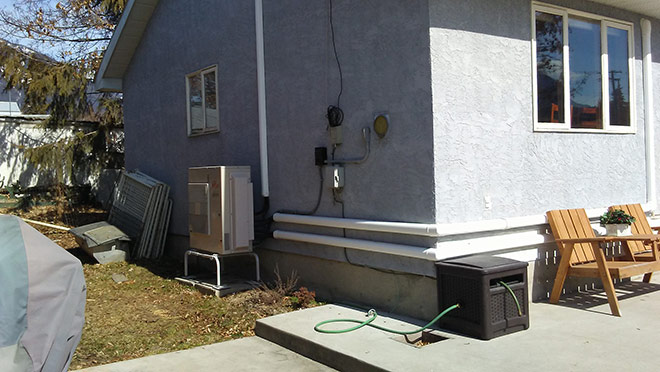Couple gets comfy with heat pump in 120-year-old Nakusp home

Rebate helps make it easy to add efficient heat to a character home in Kootenay Lake community
A retirement move from busy Kelowna to Nakusp has been a little like stepping back in time for Jim and Cindy Vanderby. The Kootenay Lake town has a single stoplight, and the Vanderbys' "new" home was originally built in 1898.
But it has taken a modern technology – the heat pump – to ensure that life in that 120-year-old home is comfortable. Facing cold, snowy winters, Jim quickly realized that the 1,841-square-foot home's electric baseboard heaters weren't going to be up to the challenge, and that they'd be costly. He briefly considered installing a wood stove for heat – a popular choice in Nakusp – but didn't want to deal with firewood or the mess it would create.
"A friend of ours has a ductless heat pump system and told us to take a look," recalls Jim. "We did and were pretty impressed. We found a local contractor here who could purchase the system for us, had him come out to do all his measurements – including where the windows and doors are – and came up with a plan. We decided to go with it."
The recommendation was to install a Fujitsu ductless mini-split heat pump, which the Vanderbys purchased with the help of a BC Hydro Home Renovation Rebate. The result? The home has stayed comfortable, even through a February cold spell that saw temperatures dip as low as -17°C.
"We're really pleased with it," says Jim. "We've learned to fine-tune the temperature. When it gets really cold, you set the temperature a bit higher to ensure the rooms get to the temperature you like."
'Set it and forget it' approach to heat pump can yield savings
Heat pumps work differently from traditional furnaces or resistant heaters such as baseboards that use fuel to generate heat. In the heating season, a heat pump works by extracting hot air from the ambient air outside and circulating that warm air through the home.
Because the heat pump is not generating its own heat, the more efficient cold climate models can be 300-500% more efficient than resistant heaters. But setting temperatures for heat pumps is more akin to setting fridge temperature than it is to setting temperature for a furnace or baseboard. A heat pump is most efficient when set to one operating temperature.
Setting back a heat pump thermostat, can cause the unit to operate inefficiently and potentially cancel out any savings achieved by lowering the temperature setting at night or while away during the day.
Unlike the way we use other heating systems, it's generally not recommended to lower the temperature overnight or when away during the day. The readjustment can cause the heat pump to ramp up sharply and lean on back-up heating sources – like the baseboard heaters in Jim's case – to quickly reach the higher temperature. And that means more electricity use and higher costs.
If you prefer to set the thermostat to a lower temperature at night, set it to no more than 2°C lower to maintain efficiency.
Jim reports that his two-month bill for the coldest stretch this past winter was $561, but that included additional usage from frequent visits – including showers and laundry – by the Vanderbys' daughter and son-in-law who are doing a full renovation on a home five houses away. There's also a good chance that once the Vanderbys adopt a "set it and forget it" approach to their heat pump – they had experimented with lowering the temperature significantly overnight – their bills will be lower.
Jim says his wife Cindy uses online MyHydro tracking of their electricity use at bchydro.com almost daily, and that the couple looks forward to comparing year-over-year electricity use next winter.
For cooling, it's likely only the heat pump's top-floor unit will be needed
The Vanderbys were pleasantly surprised last summer to learn that the overhangs on their home's verandas shielded the first floor from the intensity of the sun and kept things cool. So they expect they'll only need to use the top-floor heat pump head for cooling in the summer of 2019.
"It gets a bit warm upstairs, so that's where we'll set things up for air conditioning," says Jim.
Slippers are great, but that uninsulated crawlspace is costly in comfort and cost
Like all power smart people, the Vanderbys know that wearing their slippers keeps them cozy and allows them to set their heat pump a bit lower. But that old home has a problem that needs fixing – an uninsulated crawlspace.
"This summer, I'll try to go underneath the house to see if I can add some insulation to help," says Vanderby, who hopes to lean on his son-in-law – who's actually a contractor – for help.
While do-it-yourself insulation upgrades are tempting, insulation upgrades done by licensed contractors are eligible for up to $5,500 in rebates under BC Hydro's Home Renovation rebates. That includes rebates of up to $1,200 for basement/crawlspace upgrades.
BC Hydro advice and resources around heat pumps
Here are some BC Hydro heat pump resources: